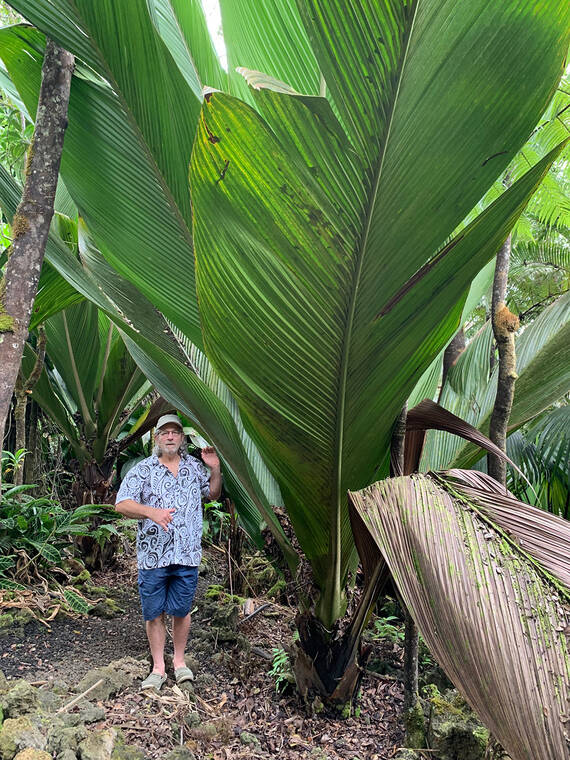The International Palm Society will be holding its 2022 biennial meeting in Hawaii with events on Kauai, Oahu, Maui and Hawaii Island. For information and to participate in the biennial activities, go to the website palms.org to get the details. On the lush east side of Hawaii Island, attendees will have the opportunity to visit private gardens not normally open to the general public. These include Floribunda, the gardens of Suchin and Jeff Marcus, where rare palms from all over the world are propagated and available for sale. The itinerary also includes the Hawaii Tropical Botanical Garden, Casa De Las Palmas, Moani-Lundkvist Garden, The Anderson Garden and several others. Folks will have the opportunity to rub elbows with world famous botanists like Dr. Andrew Henderson of New York Botanical Gardens, Don Hemmes UH Hilo Biology professor emeritus, Jason Dewees, author and horticulturist at Flora Grubb Gardens in San Francisco, and scores of other palm specialists and enthusiasts.
The International Palm Society will be holding its 2022 biennial meeting in Hawaii with events on Kauai, Oahu, Maui and Hawaii Island. For information and to participate in the biennial activities, go to the website palms.org to get the details. On the lush east side of Hawaii Island, attendees will have the opportunity to visit private gardens not normally open to the general public. These include Floribunda, the gardens of Suchin and Jeff Marcus, where rare palms from all over the world are propagated and available for sale. The itinerary also includes the Hawaii Tropical Botanical Garden, Casa De Las Palmas, Moani-Lundkvist Garden, The Anderson Garden and several others. Folks will have the opportunity to rub elbows with world famous botanists like Dr. Andrew Henderson of New York Botanical Gardens, Don Hemmes UH Hilo Biology professor emeritus, Jason Dewees, author and horticulturist at Flora Grubb Gardens in San Francisco, and scores of other palm specialists and enthusiasts.
In West Hawaii, where much of the coastal land is dry, participants will have the opportunity to visit the unique upland cloud forests of Kaloko Mauka.
This region is still covered with native forest and easily accessible in fifteen minutes from Kailua-Kona. Although it is sparsely populated, the gardens of residents are a fascinating mixture of Hydrangeas, Hoawa, Calatheas, Camellias, Koa and Kopiko. The area abounds with ancient Ohia (Meterosideros polymorpha) and gigantic treeferns. These ferns may be hundreds of years old. The native forests contain many rare and endangered species that local residents are committed to protect through the Hawaii Forest Stewardship Program. This program allows residents to dedicate and manage their properties to enhance this important and unique cloud forest watershed. It is administered through the Hawaii Department of Land and Natural Resources Forestry Division.
In the heart of the subdivision, the palm gardens of Dean Ouer and Angela Blakely will be the main attraction. They have planted hundreds of rare palm species thriving under the shade of giant ohias. Dean is also growing rare aroids in his certified nursery and Angela is experimenting to develop Hibiscus hybrids. They have a great collection of tropical Vireya Rhododendrons to brighten the garden.
Another stop on the tour is the 70-acre Kona Cloud Forest Sanctuary. Fifteen acres of abandoned pasture has been planted for testing palms, bamboos, bromeliads, orchids potential commercial forestry species and other plant materials donated by plant societies and the Hawaii State Forestry Service. Observations are being made as to their adaptability for reforestation, agricultural and landscape use. Fifty five acres are being carefully preserved in native forest.
Efforts at the Sanctuary are to protect and preserve native plants and animals. At the same time, testing and utilizing non indigenous plant materials that are environmentally friendly. That is, plants that will not displace native plants, but are able to exist in harmony, adding fruit, fragrance, and color where it is desired.
Kaloko Mauka is the home of the Hawaiian hawk, apapane, iiwi, elepaio, amakihi and many other endemic and exotic birds. Kaloko Mauka has been identified as essential wildlife habitat and forest watershed. It is the goal of residents of Kaloko Mauka to set an example that they can live in harmony with the forest and still have homes and some forest friendly agriculture activities. This is essential if our island is to have the rainfall and watershed needed to supply communities at lower elevations.
Some folks feel that East Hawaii has plenty of rain, so forests are not necessary. However, forests are like big sponges.
They slow down flooding rains, and give up moisture so that streams continue to run when rainfall is light. Without forests, flooding and drought as well as severe erosion becomes the norm. Also, grassy areas are notorious fire hazards during drought times.
Tropical forests include not only trees but under story palms, bromeliads, orchids, ferns and bamboos. Many palms worldwide are endangered due to the destruction of rainforests.
Fortunately, Hawaii is becoming a kind of Noah’s Ark thanks to the efforts of the Hawaii Island Palm Society, Hawaii Island Landscape Association, Bamboo Society, Sierra Club and other concerned groups.
Not only is it vital to protect our remaining Hawaiian forests, but to reforest those abandoned cane lands of Hamakua, Puna, Kau and Kohala with biodiverse forests thus ensuring valuable resources for future generations.
For further information on forest planting and management, please contact UH Extension Forester, J.B. Friday at 808-959-9155 or our website, konacloudforest.com.



